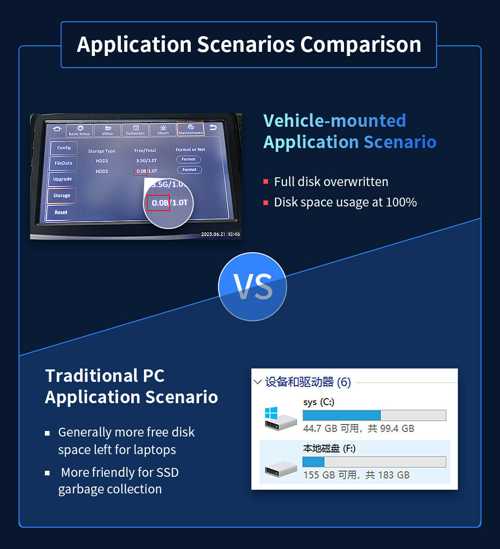Foresee/Longsys Large-Capacity SSD for Vehicle-Mounted Monitoring Systems
Available in 2.5-inch and M.2 2280 with capacity options of 512GB, 1TB and 2TB, supports 24-channel high-definition recording.
This is a Press Release edited by StorageNewsletter.com on August 25, 2023 at 2:02 pmWith the continuous development of storage technology, many vehicle-mounted monitoring applications have switched from traditional HDDs to faster, more stable and shockproof SSDs.
Click to enlarge
Foresee, an industrial storage brand under Longsys Electronics Co., Ltd., recently launched its 1st SATA SSD product designed for multi-channel vehicle-mounted monitoring systems. The SSD is already being widely used in vehicle-mounted devices.
Available in both 2.5-inch and M.2 2280, the SSD product boasts 3D TLC NAND flash chips with 3,000 P/E cycles, is DRAM-less, and features proprietary company’s firmware. With capacity options of 512GB, 1, and 2TB, it supports 24-channel 1,080p high-definition video recording equipment, providing vehicle-mounted monitoring system customers with more market-competitive storage choices.
Generally, PC users will not be affected by regular garbage collection (GC) behaviors of SSDs when there is abundant free disk space. However, compared with traditional PC application scenarios, vehicle-mounted multi-channel video recording scenarios are a bit special. In such scenarios, logical block addresses (LBAs) are not written, covered, and reused in sequence, data blocks in partitions are in different sizes, and the disk space usage rate is 100%. But with the continuous writing of video data, LBAs become very random and GC behaviors are triggered frequently, resulting in slow terminal performance that fluctuates and frame drops.
In addition, strong vibration, high and low temperature fluctuations, humidity changes, and other harsh environmental factors in such scenarios bring many challenges to vehicle-mounted monitoring systems.
FW algorithm optimizations: No frame drops in writing
The company’s SSDs for vehicle-mounted monitoring systems are made for vehicle-mounted application scenarios.
In particular, the following algorithmic optimizations have been made.
-
Bad block management:
Because SSDs are prone to bad blocks, especially in vehicle-mounted video recording scenarios where a large amount of data needs to be written and read continuously, it is necessary to adopt special bad-block management algorithms, such as bad block replacement and wear leveling, to prolong the service life of SSDs and ensure their stability and reliability. -
Data caching:
The read and write speeds of SSDs are relatively fast, so a data caching algorithm can be adopted to improve the efficiency of reading and writing data. In vehicle-mounted video recording, data caching technology can be used to cache a certain amount of data to ensure the smoothness of video recording and playback. -
Data distribution:
Data is distributed by identifying its sequence and randomness to reduce data fragmentation and implement efficient garbage collection. -
TRIM function:
SSDs require regular use of the TRIM function to clear useless data, which improves read and write efficiency and prolongs their service life. In vehicle-mounted video recording, the stability and reliability of SSDs can be ensured by regularly using the TRIM function. -
Efficient garbage collection:
Block reservation: Some blocks in SSDs are reserved for garbage collection. When a block is fully written, it can be directly marked as a garbage block, which does not require garbage collection. This can prevent frequently using garbage collection and improve the write performance. -
Fine-grained garbage collection: Splitting SSDs into smaller blocks can make garbage collection more fine-grained. This can prevent garbage collection in a whole block and improve garbage collection efficiency.
By adopting various optimization algorithms such as bad-block management, data caching, data distribution, TRIM, and efficient garbage collection, Foresee vehicle-mounted monitoring SSDs ensure that no frames drop during intense multi-channel data writing. These functions can improve the application efficiency and reliability of SSDs in vehicle video recording, and prolong the service life of SSDs in vehicle-mounted equipment by reducing data fragmentation and GC wear. They also support S.M.A.R.T firmware online upgrades, temperature control technology, LDPC, and other proprietary functions, providing terminal equipment with strong error correction capabilities in their life cycles, ensuring continuous stable operations in hot, cold, humid, and other climates and environments, and improving the reliability and security of video data.
Click to enlarge
SATA-3 interface support: Compatible with mainstream on-board equipment in the market
Vehicle-mounted monitoring systems support SATA-1 and SATA-2 interfaces. Designed in accordance with SATA-3 specs, the interface of Foresee SSDs features both backward compatibility and upward compatibility, preparing the SSDs for the future interface iterations of monitoring systems. The firm has joined hands with several on-board equipment providers to complete compatibility tests at the verification stage and gained extensive practical experience to ensure that the SSDs can adapt to mainstream vehicle-mounted monitoring systems in the market and meet the requirements for smooth speeds during simultaneous multi-channel writing.
4TB, QLC: Diversified storage options
Automotive electronics providers need to adopt more feasible storage solutions in response to the increasingly large amounts of data and costs generated by vehicle-mounted monitoring systems, wireless terminals, black boxes, and other similar devices.
For this reason, the firm is developing 4TB QLC SSD product solutions for vehicle-mounted monitoring systems. These solutions are expected to launch this year.


















 Subscribe to our free daily newsletter
Subscribe to our free daily newsletter


